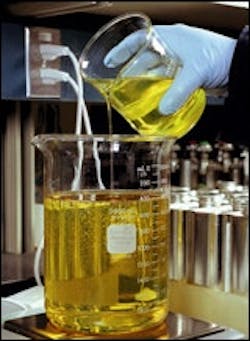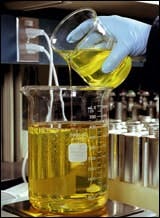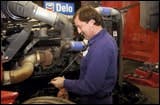New Oil Brings New Questions
The January 2007 federal deadline that requires engine manufacturers to deliver even lower tailpipe emissions has had a dramatic impact on vehicle lubrication, especially engine oil.
In order to comply with these low emissions, says Steven Goodier, technology manager for BP Lubricants, OEMs have had to fit into their exhaust systems various types of catalysts, the most common of which is diesel-particulate filters. The particulate filters, or traps, are sensitive to lubricant formulation. Goodier says today's lubricants "will poison these filters.
"Lubricants that the industry has used for many, many years will actually block the filters with sulfate ash, thus preventing exhaust gases from flowing through the exhaust pipe," he says. "Eventually, the engine will suffocate and not run anymore."
Consequently, a new oil specification has been drawn up, called PC-10. When formally released in October, however, it will be designated API CJ-4.
"This specification, in addition to meeting new engine tests and performance criteria, has been a major, major challenge for the oil industry," says Goodier. "Up until now, I think it's fair to say we have been evolving the same basic lubricants for quite a few years. We've made big changes and improvements that have led to longer drain intervals, up to 100,000 miles in some cases. This has been a big evolution, but now new CJ-4 lubricants have restrictions — constraints on the actual chemistry that can be used in the lubricant."
This major change, says Goodier, is why fleet managers cannot use the old oil in the new engines. You will be able to use CJ-4 in older engines, however, as "the new lubricants are designed to be backward compatible."
Fleet managers also should expect to pay more for lubricants, says Goodier. "We have to put more and more exotic additives in there to maintain the same level of performance which everybody has come to expect — but without as many of the active ingredients which we have been using."
Because the levels of ash sulfate, sulfur and phosphorous must be reduced, if prices remained the same, lubricant performance would be severely compromised, he says. Such a compromise would mean fleet managers wouldn't get "as near the drain intervals" that they do now, he says.
"There also would be serious issues with engine life," Goodier says. "One of the main constituents that is being heavily restricted is anti-wear. The anti-wear chemicals that are currently used in today's lubricants can't be used with the '07 engines because they will cause service problems."
Dave Tuohy, off-highway specialist for Chevron, throws up a red flag. "There is a lot of unfinished business going on with PC-10 or CJ-4," he says. "From my understanding of oils, the new 2007 on-road engines should use CJ-4 as the lubricant. But there is an issue with the current specs, called C1-4 Plus. It may — and I stress the word may — actually provide more ash which means the filters have to be cleaned more often. It still has to be proved, but I think that's probably true."
The new oil specifications have to do with a combination of extra filtration for hotter, tighter, '07 EGR (exhaust gas recirculation) engines, Tuohy says. Reduction in sulfur in the fuel is also part of the equation and, "this obviously is going to have some kind of affect on the injectors."
"We can put all these factors together and stir them around, but we still haven't seen this live," he says. "We've seen only bench tests. It's always a little different when it's live. Everything sounds good, but it's like getting a job. When you hear the job description you think, wow, this is perfect for me. Then when you get the job, you think, how did I get into this?"
He says fleet managers should realize that several things may happen. One, engine oil drains may actually be reduced. "We've yet to see that, but it's possible," Tuohy says.
A second issue could be confusion on the part of fleet managers on which oil to keep in their facilities. "Do they keep two types of 15w40 on hand?" he asks. "If they do, how do they make sure their maintenance staff is using the right oil in the right engine? There's a lot of confusion in that alone. Whenever you have two fluids that are very similar, it's enough to confuse anybody."
Another issue for fleet managers is whether or not to use CJ-4 in all of the older engines. "CJ-4 may not have as much ash as it needs for older engines," Tuohy says. "They are going to reduce phosphorous because that poisons the catalysts — but phosphorous is part of your detergent package. Sometimes, depending on who is manufacturing it, it is part of your anti-wear and a way to keep the engine oil from actually cooking or oxidizing."
If these numbers are down, Tuohy wonders if CJ-4 will actually be backward compatible? "We don't know that yet," he says. "They are planning to keep C1-4 Plus on the market. Right now I think everybody is hedging their bets, keeping C1-4 Plus for the older engines and CJ-4 for the newer engines. I don't know where they're going," Tuohy says.
Distributor Tom Pabst, branch manager for Guttman Oil Co., also questions whether CJ-4 will be backward compatible.
"The engine OEMs and oil manufacturers are trying to come up with a single engine oil that will cover '07 engines and all the engines that came before them," he says. "But as of where we stand today, I'm not so certain of that. In the short term, we might have to go to a two-oil system. There might be two types of 10w40 that fleets will have to run. They might have to run one for off-highway equipment and run another for on-highway equipment."
If that proves to be the case, he says, fleet managers and distributors alike will feel the impact because "there will be added expenses for everybody in the industry, namely additional storage requirements."
As a distributor, Pabst says, "I'd have to find space. Not only would it affect us here, but also the end users who currently operate out of one 15w40 tank that covers all their engines. They might have to have two tanks.
"Fleet managers can also expect the new oil formulation to be more expensive," he says, "because of the additional chemistry oil manufacturers are putting in to meet CJ-4 specs. Additional acids and soot can be expected as well because the '07 engines will have EGR systems."
Pabst gave this example. Typically, he says, SAE 10w40 oil has a total base number (TBN) of ash content between 10 and 12 parts per million (ppm). That represents the ability of that oil to maintain specifications while in use. Under the new guidelines, according to Pabst, ash must be reduced to 8.5 or 9.5 ppm.
"That means the ability of the oil to keep the soot out of the engine and to keep acids to a lower level is going to be reduced," he says.
Sulfated ash, says Pabst, ranges from 1.1 to 1.5 percent. Now that will be limited to a maximum of 1 percent ash content. "They're predicating that the new engines will run hotter, which they will."
Prices will increase because the oil formulation has to have a better oxidation stability package in it, Pabst says. "That's where the increased chemistry is going to come in," he says.
What an EGR system does primarily, says Pabst, is take a percentage of the exhaust emissions and put it back into the engine. "This creates a challenge for new oils," he says. "The new specs are reducing the natural physical properties of engine oils. When you do that, the sulfated ash, for example, that acts as a natural lubricity agent in engine oil is reduced. So the oil will need enhanced chemistry additive packages in these new oils." Because of the additional cost of the additive package, he predicts the cost of all refined oil products probably will go up.
"They've taken the ash out, the phosphorous out, and part of the exhaust is going to be recirculated," Pabst says. "When you recirculate that exhaust, you create additional acids and soot that you would not normally have. What you have to do is enhance your oil oxidation protection. That's the primary challenge to oil manufacturers."
As a result, Pabst says, fleet managers might be faced with three distinct possibilities. First, the need for oil analysis will become more important than ever. Second, drain intervals might have to be reduced, say, from 250 hours to 200 hours. Third, reduced drain intervals could increase oil usage.
Another consideration is condensation. "Water is always the nemesis," Pabst says. "Being from the Midwest, we have varying temperatures daily. When you remove the sulfur content, the ash and the phosphorous from the engine oil, it's going to create a sponge. Oil is going to soak up water at a greater rate than it normally would. It's going to be more difficult for engine oil to help reduce that water content."
Despite all the unanswered questions and anticipated challenges of a new engine oil formulation not yet tested beyond the bench, there still remains a strong element of optimism among these industry professionals.
"It is an exciting time, says Chevron's Tuohy. "With all these challenges that come up, we find new and better ways to do things. I believe that any time manufacturers actually boost and enhance the formulation of engine oils, it becomes robust and able to handle more things than it ever did. You get a chance to buy better and better engine oils. That is fantastic for everyone."
BP's Goodier agrees. "Although it has been a real challenge for the industry, I believe it's been a really good change in philosophy. For the first time, certainly in my career, we have to throw away all the existing tools in our tool box and invent new ones. When you have a big challenge like that, the industry has always risen to it. I believe we are going to get better quality products, find more efficient ways of using them and clean up the environment as well. You need these challenges to keep moving forward."
Distributor Pabst says, "we're all sitting and waiting and hoping the industry will come up with one formulation for all engines. I think they will."


